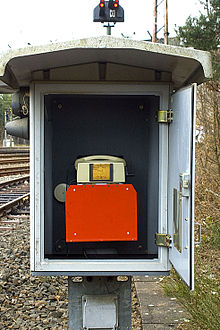Line telephone
A line telephone is a communication device on a railway line or at an operating point , with which railway employees can reach other operating points. Line telephones at unoccupied locations are housed in boxes or stalls with square locks to protect them against abuse and the weather. These boxes are marked with a black F on a white background. You stand on the open road at predetermined intervals. A distinction must be made between signal telephones, but the functionality is basically the same.
use
Mainly the line telephone connection is used by signal box personnel on lines with older security technology . They are used to send train reports , i.e. communication between two neighboring dispatchers about the sequence of trains. The train number of the departing train and the expected departure time are given. The train notification takes place between the two neighboring train notification points . It is announced by a special ringing signal in the form of a long tone. The train report is monitored by the operating points in between, such as barrier posts and block posts. Listening to the train report is especially important for the barrier guards so that they know that the barriers have to be closed.
Telephones also play an important role during construction work. They are used for communication between the supervisor on site and the dispatcher . In the past, it was common for workgroups to pick up the trunk line using a portable telephone. These train alarm rots received train reports like gatekeepers. To find the corresponding wires, the line telephone line, if it is run as an overhead line, is marked by S-shaped wire hooks at every second support point. In addition, especially in the case of permanent way work on double-track lines, it may be necessary to shut down train-operated crossing safety systems that are not prepared for the decommissioning of a track and to secure them by means of guards. Therefore, such a telephone can be found at every level crossing, which is then used by the level crossing guards.
The train radio has largely replaced the line telephone connection for communication between the driver and the operating points . However, there are still routes without train radio. In the event of a train radio failure, the line telephones serve as a fallback level. The driver can reach at least the dispatchers of the neighboring train registration points on the line telephone. If required, other participants can also be called, for example barrier posts, block posts, operators of other interlockings or other telephone stations. The long-distance telephone connections were finally replaced by the introduction of GSM-R . Especially at distances from the remote control or control centers to be controlled, the distance telephone connections have been completely taken out of service. However, a direct telephone connection that can be reached without dialing is still required between locally manned stations.
In train control operations , telephones can also be used to carry out train running reports with the train conductor. The telephone book is laid out in the telephone boxes in accordance with Group Directive 436 of Deutsche Bahn.
Calls made over the line telephone must be recorded in accordance with Section 16 (2) of the Railway Building and Operating Regulations, as a rule , using voice memories.
technology
Line and signal telephone connections are OB lines . Technically, all microphone units are connected to the line in parallel. The calls can be overheard from all telephones. The call signs are generated by crank inductors built into the terminals . Every participant on the route is assigned a call sign in the form of Morse code . A call sign board is attached to the intercom, listing all possible participants with their location and call sign and also the same call signs for train report, collective and emergency calls. The two dispatchers usually receive the short but concise callsigns "a" (short-long) and "n" (long-short). Unoccupied positions are usually called with two »u« (short-short-long-short-short-long). The dispatcher call stations are usually integrated in the general call stations. With these, the alternating ringing voltage is usually generated by a relay or electronic inductor. This ensures an audibly stronger ringtone. External intercoms and many interlockings have additional external alarm clocks so that the employees concerned can safely hear the call while they are working. Dispatchers who are usually involved in other OB lines in addition to at least two line telephone connections, receive a display to identify the connection on which they were called.
Signal telephones were usually set up at entry and block signals, and if operationally necessary also at exit signals. They are each connected directly to a separate line and only to the responsible dispatcher. This ensures that a written command dictated by telephone to the train driver or train driver only reaches the correct recipient. Train reports cannot be overheard from a signal telephone. Therefore signal telephones were marked with a special sign. Signal telephones have also been replaced by train radio and GSM-R, they are only in operation in a few places and are no longer marked as such.
Telephone cabinets and booths with the label Fo marked call stations of local loop lines within a train station. They were particularly needed for shunting and were usually replaced by portable radio equipment.
literature
- Line telephone. In: Viktor von Röll (ed.): Encyclopedia of the Railway System . 2nd Edition. Volume 9: Seaport tariffs - transition curve . Urban & Schwarzenberg, Berlin / Vienna 1921, p. 242 .
- Manual dictionary of electrical telecommunications , 2nd edition, 3rd volume Q-Z; Pp. 1609-1610

